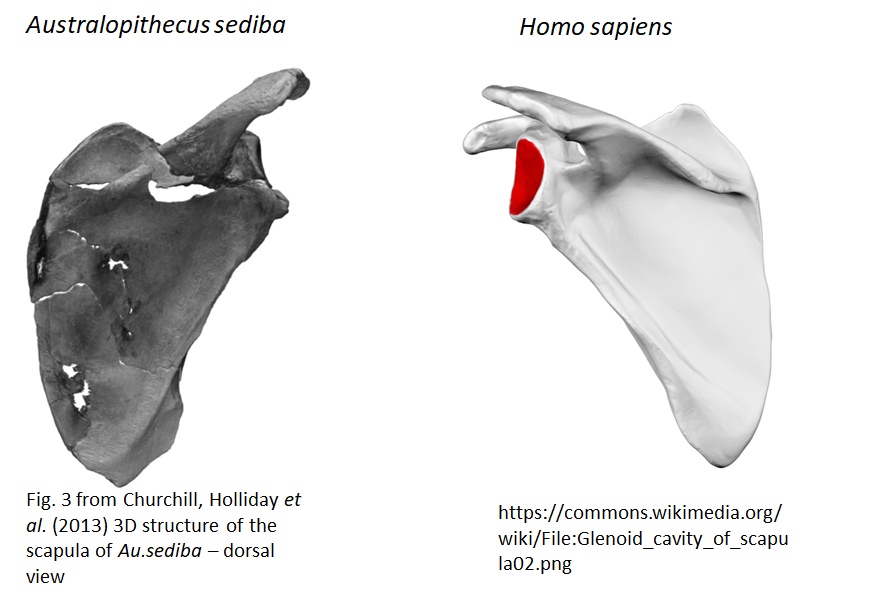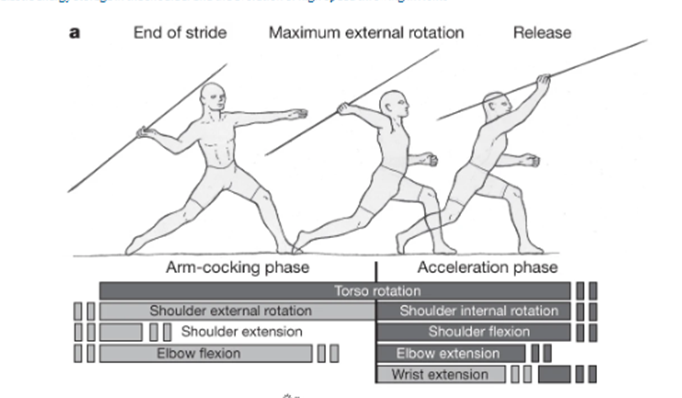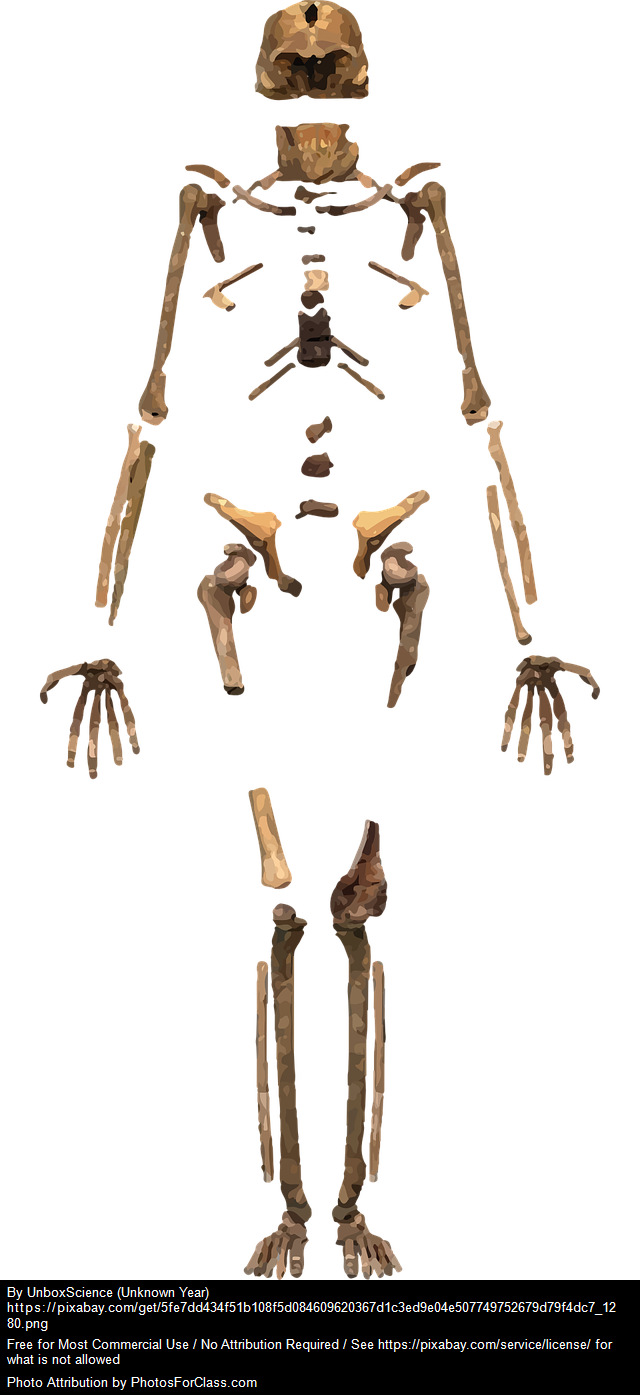Humans are the only living hominid that can throw objects accurately & at speed – while some of the other great apes can throw objects, their speed & accuracy is not the best. (In his musing on human evolution, Darwin noted that adaptations allowing this would be at a selective advantage as they would increase hunting effectiveness.) I found it interesting to look at why this is so – in both morphological & evolutionary terms – & because trends in human biological evolution are something year 13 biology students need to know about, I thought I’d write about it here.
It turns out that the ability to throw forcefully & accurately has a great deal to do with the structure of what’s known as the pectoral girdle (the collarbone & shoulder blade, which together connect the upper limbs to the rest of the skeleton) and how the upper arm bone articulates with it. Remember that the collarbone is also known as the clavicle; the shoulder blade is the scapula; and the head of the upper-arm bone, the humerus, articulates with a shallow socket on the scapula, . (And at this point, I’ll give a shout-out to the Sketchfab site, where among a treasure-trove of images you can view and interact with some excellent 3D material on human skeletal features, the skeleton and pectoral girdle among them.)
The overall form and arrangement of this part of the skeleton look distinctly different in modern humans and in our great-ape cousins, and also in early hominins such as the australopithecines. And the differences change what is biomechanically possible. So, using the other great apes and those early australopiths for comparison, let’s look first at what has changed, and then at the consequences of the change and the selection pressures that could have been in play. The following image (Berger, 2013) is a good place to start.
Those students who’ve seen my videos on bipedalism will have seen that image before, but this time around the focus is on the shoulders. In the human skeleton, if you drew a line across the top of the shoulders, you’d see that they are pretty much horizontal. But in Au.sediba, that line would be an arc, curving upwards on each side to the joint where arm & shoulder articulate. And the chimpanzee shoulder is the same.
This has to do with the way that the scapula (shoulder-blade) is oriented.

The red area on the sapiens scapula is the shallow glenoid fossa – the “socket” part of the shoulder joint (the “ball” is the rounded head of the humerus). In modern humans the glenoid fossa points out to the side, while in Au.sediba it’s more upwardly oriented. (You can also see that the projecting ‘spine’ of the shoulder-blade is more vertical in sediba.) Result? A sediba individual held its shoulders higher than we do. And the same features of the shoulder-blade send in this species are also found in Au.afarensis (Green & Alemseged, 2012).
Paleoanthropologists interpret these features of the australopith shoulder & arm as adaptations that support climbing & suspension in trees (hanging under branches – but not brachiating). This interpretation is further supported by an analysis of the hand of an even earlier hominin, Ardipithecus ramidus (Prang, Ramirez, Grabowski & Williams, 2021). However, features of the hips, legs & feet show that these species were to some extent bipedal, but didn’t move as efficiently as modern humans. This relative inefficiency of bipedal locomotion in early hominins has been interpreted as supporting the idea that bipedalism began as a posture for feeding when on the ground, rather than an adaptation for locomotion (Churchill et al., 2013; Prang et al. 2021).
So when did the modern shoulder morphology evolve?
It doesn’t appear until later (2mya), in Homo erectus, which shows a number of shoulder features that support the ability to throw accurately and at speed that I mentioned at the start of this post. H.erectus had very efficient bipedalism and no longer showed adaptations supporting climbing and hanging from branches, and some authors (Roach, Venkadesan, Rainbow & Lieberman, 2013) have suggested that selection for throwing was important in the evolution of our genus.
These shoulder features include: a more dorsal shoulder-blade, with the ‘socket’ (the glenoid fossa) pointing sideways rather than oriented somewhat upwards; and the ‘ball’ on the humerus is large and points in towards the body. This means that the arm has a very wide range of motion and the hand can be positioned almost anywhere around the body. In addition, the humerus can rotate around its long axis in both erectus and modern humans – but this movement was quite limited in the earlier hominins. These features allow forceful, accurate throwing that is powered not only by the shoulder muscles but by elastic energy stored in tendons & ligaments when the arm is drawn back ready to throw.¹

From Roach, Venkadesan, Rainbow & Lieberman, 2013.
In terms of our evolutionary history, while climbing & suspension remained significant ways of moving around, then related structural features of the shoulder, arm, & hand would be selected for. But once bipedal locomotion became the dominant means of locomotion – perhaps with a move to living in more open habitat – then other selection pressures could work on those features, ultimately resulting in the familar shoulder, arm & hand of anatomically modern humans.
¹ This storage of elastic energy – this time in the feet and legs – also contributes to our ability to run long distances.
References:
L.Berger (2013) The mosaic nature of Australopithecus sediba. Science 360(6129): 163-165 https://doi.org/10.1126/science.340.6129.163
S.E.Churchill, T.W.Holliday, K.J.Carlson, T.Jashashvili, M.E.Macias, S.Mathews, T.L.Sparling, P.Schmid, D.J.de Ruiter, & L,R.Berger (2013) The upper limb of Australopithecus sediba. Science 340(6129) https://doi-org/10.1126/science.1233477
D.J.Green & Z.Alemseged (2012) Australopithecus afarensis scapular ontogeny, function, and the role of climbing in human evolution. Science 338(6106): 514-517 https://doi.org/10.1026/science/1227123
T.C.Prang, K.Ramirez, M.Grabowski & S.A.Williams (2021). Ardipithecus hand provides evidence that humans and chimpanzees evolved from an ancestor with suspensory adaptations. Science Advances 7(9), https://doi.org/10.1126/sciadv.abf2474
N.T.Roach, M.Venkadesan, M.J.Rainbow & D.E.Lieberman (2013) Elastic energy storage in the shoulder and the evolution of high-speed throwing in Homo. Nature 498: 483-486 https://doi.org/10.1038/nature12267

